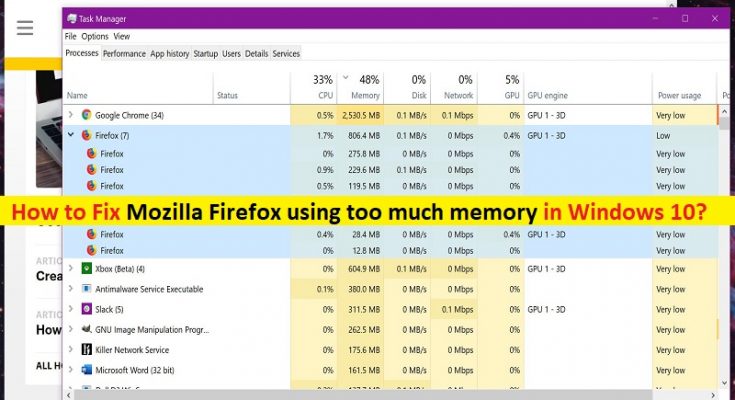What is ‘Mozilla Firefox using too much memory’ issue in Windows 10/8/7?
In this article, we are going to discuss on How to fix Mozilla Firefox using too much memory, Firefox high memory usage in Windows 10/8/7. You will be guided with easy steps/methods to resolve the issue. Let’s starts the discussion.
‘Mozilla Firefox using too much memory’: It is common Windows Problem considered Firefox high memory usage issue. This issue indicates Mozilla Firefox browser is using too much memory of your computer and causing overall system performance slowdown issue. When you open ‘Task Manager’ app in Windows PC in order to check which program/process is draining your System resources, you may experience Mozilla Firefox is showing higher percentage under CPU/GPU or Memory usage section.
There could be several reasons behind the issue including the outdated/corrupted Mozilla Firefox browser, corrupted cache of Firefox browser, interference of problematic extensions installed in browser, incorrect Firefox settings, interference of other third-party applications, malware or viruses infections in computer, and other Windows issues. One possible way to fix the issue is to update Firefox browser to latest & compatible version in computer and then check if it works for you.
This issue can also be occurred due malware or viruses infections in computer and you can run system scan for malware or viruses with some powerful antivirus software or PC Repair Tool to find and remove malware and fix Windows PC issues as well. It is possible to fix the issue with our instructions. Let’s go for the solution.
How to fix Mozilla Firefox using too much memory in Windows 10/8/7?
Method 1: Fix ‘Firefox high memory usage’ with ‘PC Repair Tool’
‘PC Repair Tool’ is easy & quick way to find and fix BSOD errors, DLL errors, EXE errors, problems with programs/applications, malware or viruses infections in computer, system files or registry issues, and other system issues with just few clicks.
Method 2: Restart Mozilla Firefox
Step 1: Open ‘Task Manager’ app in Windows PC by pressing ‘CTRL + SHIFT + ESC’ keys on keyboard
Step 2: Find and right-click ‘Firefox’ processes under ‘processes’ section, and select ‘End Task’ to close it.
Step 3: Once done, re-launch Firefox and check if the issue is resolved.
Method 3: Disable extensions, plugins and themes in Firefox

Step 1: Open ‘Mozilla Firefox’ browser and click ‘Three –horizontal lines’ icon at top-right corner, and select ‘Add-ons’ option
Step 2: Click ‘Extensions’ option in left pane, select the slider next to enabled extensions to disable it. Tap on ‘Three-Dots’ menu icon next to extension and select ‘Remove’ to remove it
Step 3: Now, click ‘Themes’ in left pane, switch back to Default theme by selecting ‘Enable’ button in ‘Add-ons Theme’ menu
Step 4: Now, go to ‘Plugins’ section, select ‘Three-Dots’ menu icon next to plugins that is causing issue in ‘Addon> plugins’ menu, select ‘Never Activate’ option to disable it.
Method 4: Update Firefox
Step 1: Open ‘Firefox’ browser and click ‘Three-Horizontal Lines’ icon at top-right corner and select ‘Preferences’ option
Step 2: Scroll down to ‘Firefox Updates’ section and select ‘Check for updates’ option. Firefox will check for updates and if an update is available, it will update automatically or prompt you to install, depending on your settings.
Method 5: Use The About:Memory menu to minimize memory usage

Step 1: Open ‘Firefox’ browser and type ‘about:memory’ in URL bar and hit ‘Enter’ key to open it
Step 2: Find and select ‘Minimize memory usage’ option. If successful, a Memory minimization completed message will appear. You can repeat this process at any point.
Method 6: Open Firefox in Safe Mode
Step 1: Open ‘Firefox’ browser and click ‘Three-Horizontal Lines’ at top-right corner and select ‘Help > Restart with add-ons disabled’
Step 2: Confirm to restart Firefox in Safe Mode. Once Firefox is start in Safe mode, check if the issue is resolved.
Method 7: Change hardware acceleration settings

Step 1: Open ‘Firefox’ browser and click ‘Three-Horizontal lines’ icon at top-right corner and select ‘Preferences’
Step 2: Under ‘General > Preferences’ section, uncheck ‘Use recommended performance settings’ option to view additional settings. From there, reduce the Content Process limit value to limit the number of additional running Firefox processes and reduce memory usage in processes.
Step 3: Also, you can disable hardware acceleration completely by unchecking ‘Use hardware acceleration when available’ option.
Method 8: Reset Firefox to default settings
Step 1: Open ‘Firefox’ browser and select ‘Three-Horizontal Lines’ icon and click ‘Help > Troubleshooting information’
Step 2: Select ‘Refresh Firefox’ option and confirm it to reset Firefox. Wait to finish the process and once finished, restart Firefox browser and check if the issue is resolved.
Conclusion
I am sure this article helped you on How to fix Mozilla Firefox using too much memory, Firefox high memory usage in Windows 10/8/7 with several easy steps/methods. You can read & follow our instructions to do so. That’s all. For any suggestions or queries, please write on comment box below.



